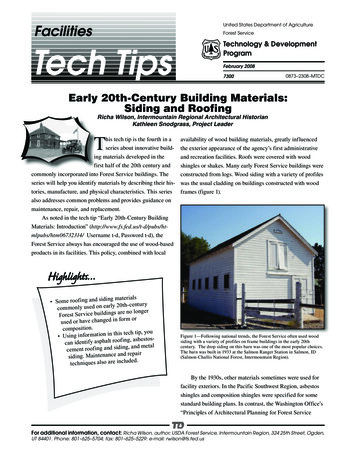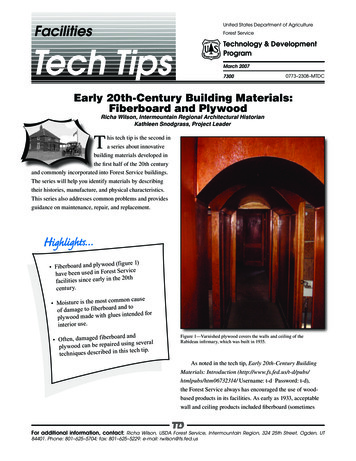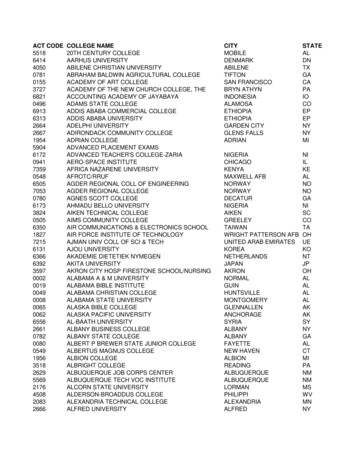
Transcription
United States Department of AgricultureFacilitiesForest ServiceTechnology & DevelopmentProgramFebruary 200873000873–2308–MTDCEarly 20th-Century Building Materials:Siding and RoofingRicha Wilson, Intermountain Regional Architectural HistorianKathleen Snodgrass, Project LeaderTThis tech tip is the fourth in aseries about innovative building materials developed in thefirst half of the 20th century andcommonly incorporated into Forest Service buildings. Theseries will help you identify materials by describing their histories, manufacture, and physical characteristics. This seriesalso addresses common problems and provides guidance onmaintenance, repair, and replacement.As noted in the tech tip “Early 20th-Century BuildingMaterials: Introduction” 4/ Username t-d, Password t-d), theForest Service always has encouraged the use of wood-basedproducts in its facilities. This policy, combined with localmaterials Some roofing and siding20th-centur ycom monly used on earlyare no longersForest Service buildingfor m orused or have changed incomposition.s tech tip, you Using information in thig, asbestoscan identify asphalt roofin, and metalingcement roofing and sidairrepandsiding. Maintenanceed.ludinctechniques also areavailability of wood building materials, greatly influencedthe exterior appearance of the agency’s first administrativeand recreation facilities. Roofs were covered with woodshingles or shakes. Many early Forest Service buildings wereconstructed from logs. Wood siding with a variety of profileswas the usual cladding on buildings constructed with woodframes (figure 1).Figure 1—Following national trends, the Forest Service often used woodsiding with a variety of profiles on frame buildings in the early 20thcentury. The drop siding on this barn was one of the most popular choices.The barn was built in 1933 at the Salmon Ranger Station in Salmon, ID(Salmon-Challis National Forest, Intermountain Region).By the 1930s, other materials sometimes were used forfacility exteriors. In the Pacific Southwest Region, asbestosshingles and composition shingles were specified for somestandard building plans. In contrast, the Washington Office’s“Principles of Architectural Planning for Forest ServiceFor additional information, contact: Richa Wilson, author; USDA Forest Service, Intermountain Region, 324 25th Street, Ogden,UT 84401. Phone: 801–625–5704; fax: 801–625–5229: e-mail: rwilson@fs.fed.us1
Administrative Improvements” (1938) noted that composition roofing was acceptable only on temporary structures.After World War II, the Forest Service increasingly procuredasphalt- and asbestos-based building materials. From a practical standpoint, these products were desirable for their affordability, ease of installation, and resistance to fire, rot, andinsects. They reinforced a modern, progressive image as theForest Service entered the second half of the 20th century.This tech tip focuses on roofing and siding materials commonly used on early 20th-century Forest Servicebuildings—materials that are either no longer used or havechanged significantly in form or composition. The techtip supplements information in the tech tips “Overview ofRoofing Materials for Forest Service Facilities” 4/ Username: t-d,Password: t-d) and “Overview of Siding Materials for ForestService Facilities” 8/ Username: t-d, Password: t-d).Aggregate pressed into the mats increased durability.After 1900, stone granules replaced cinders as the aggregateof choice. Colors were limited to black and shades of red andgreen until the 1930s when manufacturers began using ceramic granules. These granules offered a wider range of colors that could be combined to create a variegated appearance.Many homeowners chose to modernize their houses bycovering existing wood-shingled roofs with asphalt shingles.The asphalt shingles, valued for their fire resistance andlower cost, came in numerous colors, patterns, and shapes.Often they were characterized by the method of installation:American method, French method, or interlocking. American method or "straight" shingles of the 1920sand 1930s were square or rectangular. The shingles wereinstalled to overlap the course below. They could bestraight laid, abutting adjacent shingles, or Dutch lap,overlapping adjacent shingles (figure 2).11”Asphalt RoofingThe American composition roofing industry emerged inthe 1840s, and by the 1880s it was flourishing. Asphalt-impregnated fibers with or without aggregate (such as cinders)pressed into the exposed surface were packaged for roofingas long strips on rolls. A shift from roll roofing to hand-cutasphalt shingles began in 1903. The asphalt roofing industrygrew during World War I because asphalt shingles were easyto transport and were made from materials that weren’t inshort supply during the war.The popularity of asphalt roofing grew in the 1920s,due in part to the National Board of Fire Underwriters’ campaign to eliminate wood-shingled roofs. The introduction ofasbestos reinforcement further enhanced fire-resistance andstrength. Consumers appreciated the variety of machine-cutshingle shapes and sizes.The asphalt-saturated mats of early roofing were madeof cotton or wool fibers known as rag felt. By the early1940s, the roofing industry relied more on paper or wood fibers reinforced with asbestos fibers. Manufacturers switchedto inorganic mats made of fiberglass in the late 1970s as concerns over asbestos increased.27”16”8”Straight LaidPrevailing wind3”13”13”3”16”Dutch Lap16”Figure 2—This drawing shows typical sizes, shapes, and installation forAmerican method asphalt shingle roofing.
French method shingles are shaped like diamonds orhexagons in an attempt to imitate slate roofs of Frenchchateaux. Historically, they were so large (12 by 12inches and 16 by 16 inches were standard sizes) thatthey required storm anchors (hooks to hold the edgesdown during high winds). Because they had littleoverlap on their edges, French method shingles providedonly one layer of roofing. This was acceptable whenthey were installed over existing roofing, but not innew construction as the French method provided onlyminimal protection of the roof deck (figure 3).24"”Figure 4—This drawing shows typical sizes, shapes, and installation forinterlocking asphalt shingles.12”21"1236”12”921”Three-Tab Asphalt Shingles192”36”12”Figure 3—This drawing shows typical sizes, shapes, and installation forFrench method asphalt shingles.Hexagonal Asphalt Shingles Interlocking shingles, whether installed in strips oras individual shingles, have high wind resistance andprotect the roof decking better than other types. Theywere available by the late 1920s and were popularduring the 1930s and 1940s. The complex shapes hadears, catches, and slits that interconnected with theshingle course below to create a basket weave pattern.Interlocking shingles worked well on the rolled eavesof cottage style houses (1930s and 1940s), where theyevoked thatched roofs (figure 4).Individual shingles fell out of favor as more companiesproduced strip shingles, with or without tabs. Tab shingleshave cutouts that minimize buckling and mimic the appearance of individual shingles. By 1935, most major manufacturers were producing 12- by 36-inch tab shingles (figure 5)that looked similar to those manufactured today.Figure 5—This drawing shows typical sizes, shapes, and installation fortab-style asphalt shingles.IdentificationMost people can identify asphalt roofing because of itsdistinctive black, asphalt-saturated backing and its granularsurface. Organic mat (felt or cellulose) base shingles areheavier than the fiberglass base asphalt shingles that aremore commonly used today and may include asbestos-containing materials (ACM). Check engineering records forACM inspection reports, many of which were completed forForest Service facilities in the 1990s. If no records exist, senda sample of the roof to a laboratory for inexpensive testing.Only properly trained employees or contractors may cut thesample.3
easy to find. Manufacturers are increasingly offering specialty shapes and interlocking shingles. For unique shapesAsphalt roofing has a relatively short life of 10 to 30or sizes, new shingles can be cut from roll roofing or tablessyears. Cycles of dampness and dryness will break down theasphalt, which can lead to warping, buckling, blistering, and shingles using a utility knife.It is worthwhile to determine whether ACM is present,loss of granules. Asphalt shingles also deteriorate with oxidabecausedoing so may save time and money in the long run.tion and exposure to heat, ultraviolet rays, corrosive chemiThe Missoula Technology and Development Center (MTDC)cals, and biological growth. Damage is usually most evident“Facilities Toolbox” (http://www.fs.fed.us/eng/toolbox/at roof valleys and changes in roof pitch. Foot traffic andfalling branches can also harm the roofing, particularly when haz/haz02.htm) provides information about ACM in ForestService facilities. Under Forest Service regulations, employthe granules fall off and expose the base.ees are not allowed to work with friable asbestos. An excepExtend the life of asphalt roofing with regular maintion is the Plumas National Forest’s Asbestos Crew Services,tenance and preventive measures. Clean gutters and downan enterprise team certified to inspect and abate ACM. Withspouts. Trim overhanging branches so they do not scrape orproper training and equipment, Forest Service personnel canfall onto the roof, and remove organic debris such as leaves.work with nonfriable ACM.Make sure there is adequate attic ventilation to minimizeheat and moisture buildup. Maintain the roof’s flashing toprevent the roof from leaking.Install a zinc strip near or at the roof ridge to minimizegrowth of moss or fungus. Rain will wash small quantitiesAsbestos-Cement Roofing and Sidingof the zinc, which acts as a fungicide, onto the roof. In cerIn the early 1900s, manufacturers reinforced Portlandtain coastal areas, airborne algae can cause dark streaks oncement with asbestos fibers to create a fire-resistant andasphalt shingles. These can be lightened with a solution ofbleach and trisodium phosphate cleaner added to warm water durable building material. The product, first made in 1905,in the proportions recommended by the manufacturer. If any served as a coating for boilers, steam pipes, and equipmentthat generated heat. Asbestos-cement coatings also were usedof the solution gets on the structure’s siding or trim, rinse itto patch roofs and seal areas where pipes or other items penoff immediately to avoid color changes or streaking.etrated the roof.Wear rubber gloves, eye protection, long-sleeve shirts,The production of asbestos-cement sheets became possiand long pants when mixing or using trisodium phosphate orbleach solutions. Follow safety precautions printed on cleaner ble in 1907 when Austrian Ludwig Hatschek brought his patand bleach labels. Avoid scrubbing or high-pressure washing, ented process to the United States. Forming and curing processes were improved and it was not long before shingles andwhich would remove the granules.Use roofing cement to patch small holes and cracks and corrugated panels for roofs and walls were manufactured. Awide range of asbestos-cement products, such as pipes, fauxto secure loose or curling shingles. Do not apply too muchcement or the shingles will not lie flat and will be more vul- ceramic tiles, and decorative moldings, became available.Successful manufacturers included Eternit, Johns-Manville,nerable to wind damage.and the Asbestos Shingle Slate and Sheathing Co.If asphalt roofing has deteriorated beyond repair, it isThe National Board of Fire Underwriters, with its initime to install new roofing. New roofing can be placed overthe existing roofing if the roof has only one layer of shingles, tiative to eliminate the fire hazards of wood shingles, wasinstrumental in the public’s acceptance of asbestos-cementthe decking is in good condition, and the roof structure isroofing. By the 1920s, large asbestos-cement roof shinglessound. Otherwise, remove the existing roofing and makewere available in a natural gray color, as well as red andany needed repairs before installing new roofing felt andblue-black colors that resembled tile and slate. Pigments, eishingles.ther added to the wet mixtures or rolled into surfaces, fadedReplacement roofing that matches the historic appearwhen they were exposed to the elements.ance of American method shingle installation is relativelyMaintenance and Repair4
Like their asphalt counterparts, asbestos-cementshingles were characterized by a variety of shapes (square,rectangular, diamond, chamfered, scalloped, and ogee) andmethod of installation (American, French, or interlocking).Asbestos-cement roofing tiles shaped to imitate clay tilesfound on French and Spanish-style buildings were also produced (figure 6).White, gray-pink, and gray-green were the most common of the limited colors available for asbestos-cement siding. In the 1940s, speckled patterns were produced by pressing granules of pigment into the surface (figures 8 and 9).Manufacturers began offering deeper hues of brown, green,and coral during the booming 1950s housing market. Despitethe available colors—or perhaps because of them—manystructures with asbestos-cement siding were eventuallypainted.Figure 6—Asbestos-cement roofing tiles were popular on period revivalstyles such as the Mission and Spanish Eclectic styles, which were mostcommon in the Southwest and Florida.Siding made of asbestos cement was another popularbuilding material. Individual square, rectangular, andhexagonal shingles dominated, although long planksresembling clapboard were offered by the late 1930s. Thesurfaces of siding produced in the 1920s and early 1930swere smooth. Textured finishes, particularly wood-grainpatterns, were available beginning in 1937 (figure 7). Sears,Roebuck and Co. was one of the first suppliers to introduceasbestos-cement siding with a wavy bottom edge.Figure 8—The pigment granules pressed into the surface during manufacturing are clearly visible on this broken piece of asbestos siding.Figure 9—The broken piece of siding shown in figure 8 is from this 1957house at the Shake Creek Guard Station on the Sawtooth National Forest,ID (Intermountain Region).Figure 7—The wood-grain pattern on these asbestos siding shingles makesthem look similar to wood shingles when viewed from a distance.5
Installing asbestos-cement shingles, whether on roofsor walls, was relatively easy. Most shingles, typically 12 by24 inches, were easy to handle and came drilled for nailing. Often, they were applied over existing materials usingfurring strips. Asbestos-cement products, once deemed amiracle material, remained popular until the 1970s when theU.S. Environmental Protection Agency (EPA) began regulating asbestos-containing materials.drips, allowing drying time before cleaning the next section.Do not use strong trisodium phosphate solutions on surfacesthat have been covered with latex paint unless you want toremove the paint. Wear rubber gloves, eye protection, longsleeve shirts, and long pants when mixing or using trisodiumphosphate or bleach solutions. Be sure to follow safety precautions printed on cleaner and bleach labels.Asbestos cement is brittle and susceptible to crackingand chipping. Minimize damage by controlling the environment. For example, plant shrubs or flower beds around theIdentificationfoundation so siding will not be damaged by lawn equipment.For Forest Service facilities, check the 1990s asbestosAdd a drip cap below the bottom row of siding to serve as asurveys and other engineering records to see if asbestos-cebumper. Trim branches that might fall on the roof.ment siding or roofing has been identified. If not, conductPatch hairline cracks with clear epoxy. Larger gaps cana visual inspection. Asbestos-cement siding and roofing isbe patched with a thin grout made of Portland cement andsubject to impact damage, so look for areas where the matewater. For cracks larger than 1 8 inch, use grout with a thickerrial has broken. You may be able to see the material’s colorconsistency or add sand to the grout. After patching, keepin cross section if you look at the edge of a broken section.the grout damp for about a week to keep it from drying soSiding or roofing that is gray inside usually is asbestos cequickly that it cracks.ment. When lightly tapped, asbestos-cement products usuallyIf the siding or roofing must be replaced, contact asound harder than wood, almost like ceramic. Siding or roof- certified asbestos worker and prepare an abatement plan.ing that is brown inside is probably wood-based hardboard.Replace damaged siding or roofing with an alternative mateSiding or roofing that is red inside is probably clay tile.rial, such as nonasbestos fiber-cement shingles or fiberboard.Match the original material in appearance as closely as possible. Consult with your heritage staff and State HistoricMaintenance and RepairPreservation Office to determine which substitutions are acThe EPA does not consider asbestos-cement products to ceptable.be friable (easily crumbled or reduced to powder) becausethe cement acts as a binder. However, these products canbecome friable if they are severely deteriorated or if theyhave been disturbed mechanically by drilling, sawing, sanding, or grinding. If you need to do any of these things during Steel and Aluminum SidingSteel siding, formed and joined to resemble clapboard,maintenance or repair, a certified asbestos worker and anwas patented as early as 1903. It was used on a limited basis,abatement plan will be needed. Contact your regional envimainly because it was susceptible to water penetration andronmental engineer or refer to the “Hazmat in Buildings”rust. Indiana machinist Frank Hoess corrected this problemsection in MTDC’s “Facilities Toolbox” (http://www.fs.fed.by creating interlocking flanges on the top and bottom ofus/eng/toolbox/haz/haz02.htm) for more information.Use trisodium phosphate cleaner added to warm water in siding panels. Hoess patented his steel siding in 1939, usingthe proportions recommended by the manufacturer to remove it on a small housing development in Chicago. The demandsthat World War II placed on the steel industry halted furtherdirt or light stains. Bleach may be added to the mixture todevelopment and use of steel siding.remove moss or other fungi. Start at the bottom, cleaning aThe nation’s housing shortage after World War II revivedsmall section at a time. Trisodium phosphate may change thethe metal siding industry. However, steel siding became lesspaint color if it contacts the surface for more than a couplecommon until the late 1970s, when a process was developedof minutes. To avoid streaking, rinse each section and any6
to manufacture seamless steel siding. Hoess collaboratedwith a company in 1946 to produce his interlocking sidingfrom aluminum rather than steel. It was installed as an unfinished material, either left to weather or primed and paintedwith house paint.In 1947, Jerome Kaufman invented a process to bakeenamel coating onto aluminum siding and formed the AlsideCo. Initially, colors were limited to white, gray, and cream.Later, additional pastel hues were introduced. Smooth or textured surfaces, with or without an insulated backing, were offered, as were aluminum accessories, such as soffits, corners,and trim.The building sector responded to these innovations andby the late 1940s, aluminum siding was favored as an inexpensive material that could be installed easily and quickly.Manufacturers, such as Reynolds Metals Co., promoted thematerial as rot and fire resistant, offering it in panels, clapboards, and weatherboards. Widths of 4, 6, 8, and 10 incheswere common. Lengths ranged fr
a ir. Figure 1—Following national trends, the Forest Service often used wood siding with a variety of profiles on frame buildings in the early 20th century. The drop siding on this barn was one of the most popular choices. The barn was built in 1933 at the Salmon Ranger Station in Salmon, I











